Quince Brown’s “Okie” P-47 and some 78th FG history
Since my Osprey book, "Aces of the 78th Fighter Group" is now available for pre-order at Amazon (pay no attention to the "place holder" artwork shown, Mark Postlethwait's painting of Gene Roberts scoring his 2nd of 3 victories on 30 July 1943 is vastly superior), here is a bit of history of the group and a model of one of the airplanes flown by their leading ace, Quince Brown.
Formed in January 1942 with personnel from the 1st and 14th Pursuit Groups, the 78th Pursuit Group was originally intended to fly the P-38 Lightning as one of the four long-range escort groups for the newly-formed Eighth Air Force. Contrary to official Air Force history written to fit later facts, at the outbreak of war there was a considerable body of belief in the upper echelons of the AAF that European combat had already proven that bombers needed fighter escorts in order to survive. There was a considerable body of belief among the “bomber men” that the B-17 and B-24 were several orders of magnitude different and better than the British and German bombers that had proven unable to defend themselves in daylight bombing missions and that they were indeed “self-defending” bombers. However, the 1st Pursuit Group gave birth over December 1941 and January 1942 to the 14th, 82nd and 78th Pursuit Groups, all of which were to get to England as quickly as possible to act as escorts. At the time, the P-38E with drop tanks was the only American fighter capable of fighting at the altitudes where air combat took place over Europe, with the range to provide escort.
The 78th PG became the 78th Fighter Group in May 1942 with the change in AAF designations, based at Hamilton Field north of San Francisco, where they were losing an average of one P-38 a week to fatal crashes as pilots discovered the vicissitudes of the airplane. After a long struggle during the first four months of existence when pilots were removed and sent overseas willy-nilly - one being a young 2nd Lieutenant who made the mistake of chasing Navy Wildcats under the Golden Gate while the base commander was driving across the bridge; Richard Bong was told to stock up on 2nd Lieutenant's bars since he'd never amount to more, as he was packed off to New Guinea - the group gradually became combat-ready.
In June, the four P-38 groups began movement to England. The 1st Fighter Group demonstrated the impracticability of delivery by air when one entire flight went down on the Greenland icecap, and all other aircraft were sent by sea. The 1st FG arrived in England in August and commenced training. The 14th arrived in September. By that time the U.S. was committed to Operation Torch, the invasion of North Africa, and the two groups were soon sent on to the 12th Air Force, as was the 82nd FG when they arrived in November. The 78th arrived in England at the end of November and took up residence at Goxhill, where they began to receive new P-38G aircraft with the expectation that they would support the bombing campaign against the U-boat bases on the French Atlantic coast in January 1943.
By January, however, the three P-38 groups in North Africa were down to 45 aircraft between them, and USAAF Commanding General Hap Arnold ordered that all aircraft, and all pilots other than flight leaders, squadron commanders and group staff of the 78th would be sent to North Africa to make up losses. 8th Air Force Fighter Command was now reduced to the RAF veterans of the 4th Fighter Group, the newly-arrived 56th Fighter Group and the ghost of a fighter group, the 78th. All were now to be equipped with the P-47 Thunderbolt. The 4th had combat experience, but no experience of the P-47, while the 56th had experience with the P-47 having been the first to equip with it, but no combat experience; the 78th had no combat experience, no experience of the P-47 and no pilots. 8th Fighter Command was under orders to commence combat operations in April 1943, with an airplane that could barely get across the English Channel to the Dutch coast.
When the first P-47s arrived at Goxhill, the pilots were amazed at its size, and also took note of the very strongly worded instructions in the Pilot's Notes about not initiating a steep dive above 23,000 feet. On February 6, Captain Herb Ross took one up for a check ride. Climbing to 35,000 feet, he pushed over to see what the problems were. Speed built rapidly: at 27,000 feet, Ross experienced tail buffet so intense the stick flailed out of his hands; grabbing the stick as he sped through 20,000 feet, the controls felt ‘set in concrete' and he began feeding in nose-up elevator trim. As he passed through 10,000 feet, certain his time had come, the racket stopped, the nose gradually came up and the Thunderbolt leveled off at 5,000 feet. Ross called to ask whether he should land the damaged airplane or bail out. Told to bring it in to have a look, he was so shaken he had to be helped from the cockpit on arrival. A short inspection certified the airplane Class 26, damaged beyond repair. The paint was off the leading edges of all flying surfaces; wing spars had been pulled back and the sheet metal failed at the wing roots; vertical and horizontal stabilizers were pulled back with root failure, and most of the fabric on the elevators was hanging in tatters. As Harry Dayhuff recalled, ‘It was the sickest looking lately-new P-47 one can imagine, having only collided with air.' Ross gained the nickname "Rocket" from the incident. The pilots now understood the P-47 was as dangerous as a P-38 when it came to the little-understood problem of “compressibility.” Fortunately, metal elevators soon arrived to replace the fabric elevators on the P-47C-2s, and all subsequent P-47s arrived so equipped.
The 78th began receiving RAF-trained American pilots who had transferred to the AAF in late February. Group Commander Col. Arman Peterson and his squadron leaders managed to learn enough about the P-47 to get things moving; staffer Bob Eby created the gun-aiming plan that would be used by all other P-47 groups. The 78th moved from Goxhill to Duxford in late March. Every man who ever served in the group remembered the steam heat of the permanent RAF base and the fact that only the 4th lived better than they did, over at Debden. Huie Lamb recalled that “Compared to everyone else in the Eighth, we lived in a country club.”
84th Squadron CO Major Gene Roberts decreed all airplanes of the 84th would be polished with beeswax to improve airspeed. As Sergeant James Tudor remembered, “It was great fun to forget about the wax and slip, then fall off the wing with a full tool box or take off the big heavy section of the bottom cowl and have it slip and come crashing down on your foot. I believe it gave a whole two to five mile an hour increase in speed.” The first combat missions were flown in April, with each of the three squadrons, the 82nd, 83rd and 84th flying with the 4th on coastal sweeps.
In late April, the first AAF-trained pilots trained on the P-47 arrived. Among them was an older 1st Lieutenant who had been a flight instructor for the previous year; only Col. Peterson had been in the AAF longer than Quince Brown, who had more flight experience and more P-47 experience than any of the group leaders did. He was assigned to the 84th Squadron, where Gene Roberts quickly promoted him to flight leader. Ernie Russell, who would later fly as wingman and element leader to Brown remembered, “He could joke and had a little smile, but he was not brash or loud; however, you knew that he meant what he said and, if tested, would tell you what he thought, never loudly, but as matter of fact. He was not prone to jest, but he did have a good sense of humor. Above all he was not a braggart; it just wasn't in his makeup. He was known by all in the squadron as one of the best pilots, though he would never tell you that — like a cowboy, ‘the proof was in the pudding.' He had excellent vision - better than mine, and I had 20/10 vision - good peripheral vision that is essential to seeing movements in the sky, and good judgment. All that combined with the fact that he was an excellent shot made him a superb fighter pilot.” Born in 1917 in Hydro, Oklahoma, he was the fifth of five sons, hence his name. From letters home preserved by his family, Brown reveals intelligence and that dry sense of humor often found in Oklahomans.
In May 1943 the 78th began flying missions as a group. They quickly ran into the Luftwaffe. On May 15, the first three victories were scored. Two of the three victorious pilots were in turn shot down, one of them being Captain Elmer “Mac” McTaggart (who later taught me aerobatics in the 1970s). He managed to evade the Germans and was put in touch with the local Resistance. After two days of relentless German searches, he was dressed as a Basque peasant, given a bicycle, and told to head south to the Pyrenees. McTaggart took two weeks, traveling on back country roads through western France, to get to thePyrenees where he was able to contact the people whose names he had been given. Taken up to the border, he crossed into Spain. At the first village, he used the phone number he had been given to contact the American embassy in Madrid. The Guardia Civil arrived to collect him and tossed him in jail. Ordinarily, an evader might spend 4-6 weeks in jail awaiting release to the embassy. McTaggart was in a cell with men who had already done that and the next day everyone in the cell was collected and sent to Madrid. By June 18 they were in Gibraltar awaiting a flight back to England, where McTaggart arrived on June 23, five weeks after his bail out. It was the 8th Air Force record for evasion.
On July 1, Col. Peterson was killed in combat over Holland. Two days later, Bob Hope arrived with his USO tour. As Hope later recalled, “they were the toughest house I played in the entire war.” The 8th AF finally felt capable of attempting a sustained campaign, and the month was spent on the “Little Blitz.” On July 30, the 78th made their first mission using unpressurized ferry tanks. Helped by a tailwind and crossing into Holland at a lower altitude so they could keep the tanks, the group was able to cross the German border and rendezvous with the 165 B-17s returning from bombing the Focke-Wulf factory at Kassel. They were 50 miles east of the furthest penetration yet made by American fighters, and they caught the attacking Luftwaffe fighters by surprise. In ten minutes' combat, 16 German fighters were shot down for a loss of two P-47s. Captain Charles London scored two to become the first 8th AF ace, while Gene Reynolds scored the first triple, and Quince Brown shot down his second. It was the most important air combat in the history of 8th Fighter Command: for the first time, American fighters had taken on the Luftwaffe at maximum range and scored decisively. Returning from combat at low level, Quince Brown became the first 8th AF pilot to strafe a target, taking out the first of hundreds of trains that would fall victim to P-47s in the next 21 months.
In September, the group received 108-gallon paper tanks and were able to penetrate 200 miles into Germany with ten minutes' fuel for combat carrying one tank on the centerline. On September 27, 45 Thunderbolts led by Harry Dayhuff headed for rendezvous ten miles west of Emden. They arrived at the rendezvous to find 30 Bf-109s making rocket-firing passes as two huge fireballs fell away from the U.S. formation. The Germans had no expectation of meeting American fighters, and the 78th hit them hard, shooting down 8 including Quince Brown's fifth. With the Germans broken up in the five minute fight, the Thunderbolts regrouped and stayed with the bombers, beating off attacks until fuel forced them to depart 40 miles off the Dutch coast.
Following the German defeat of the 8th Air Force at Schweinfurt on October 14, weather closed in over Europe for the next two months, allowing the 8th to hide its loss and make the turnaround it needed. The Thunderbolt was given wing pylons in November and by the end of the year had the range to take the bombers almost all the way to Berlin. The 78th also first learned to use the Thunderbolt as a dive bomber at the end of December 1943, a mission that would become increasingly important in coming months.
The Spring of 1944 saw The Battle of Germany won, as the 8th Air Force decisively defeated the Luftwaffe, the main requirement needed to invade the Continent in June. On March 16, 1944, Quince Brown fought one of his most memorable combats. For element leader Ernie Russell, it was his most memorable day of the war. “Our time with the bombers had been uneventful - just a lot of tricky crossover turns, rubbernecking, looking for bogeys and disappointed that the Jerries didn't turn up. I'm sure the fact there were no Jerries didn't bother the crews on the ‘big friends' half as much as it did us.” Russell and wingman 2nd Lieutenant Ross Orr followed as Brown and his wingman 2nd Lieutenant W.N. Smith went looking for targets of opportunity.
Brown dove towards St. Dizier Airdrome, a major fighter base southwest of Paris. The four were indicating over 450 mph as he shallowed the dive, then pulled out a hundred feet above the hillsides. They were still indicating over 400 mph as Brown hit one Bf-109 in the landing pattern. Russell suddenly found himself 250 yards behind another 109 approaching to land. “As the 109 filled my gunsight, I pulled the bright dot in the middle of the glowing ring along his line of flight for a deflection shot of about thirty degrees and squeezed off a burst. My closure rate was so great I passed over him a fraction of a second later.” Russell and Orr followed Brown and Smith and dove for the south end of the runway, lining up abreast. “We made a sharp diving turn and lined up on the runway. We were several hundred feet east of Quince, who was lined up on the runway. A Ju-88 was just about to take off in front of him, while I spotted a Bf-110 on a taxiway just to the right of the strip, presenting me with a head-on shot. I centered needle and ball and waited till he was about 400 yards away, then opened fire. I heard my guns over the roar of my engine at full throttle. Almost instantly, the front of the 110 lit up with the flashes of API rounds.” Brown exploded the Ju-88 and the four P-47s joined up so low Russell was afraid of hitting the ground as they raced away. “We had taken the base by surprise, for there was no anti-aircraft fire. However, we strongly suspected we had stirred up a hornet's nest.” Brown turned northwest as they stayed low till the field was out of sight before climbing to altitude.
In instant later, Russell spotted a mixed group of Bf-109s and Fw-190s diving through the haze. Yelling “Break Right!” he slammed the throttle into War Emergency Power, turning right as hard as he could to meet the attacker. “He had the advantage of speed, altitude and position; my luck was he wasn't behind me, and was presented with a tricky firing angle. He missed and flashed past. From experience, I was confident I could out-climb and out-turn him, but more important I could turn on a dime at the top of a near-vertical climb and give back change; we called that maneuver a ‘stall turn.' My chief advantage was that the Jug happened to have the fastest aileron roll of any fighter, even at low speed. The maneuver was fairly simple: in a vertical climb at full power, just before I stalled, I would roll and smoothly apply rudder in the direction I wanted to go, nurse the stick back to get the nose down, and then accelerate. I could almost fly back down the air corridor I had ascended.” As Russell looked over his shoulder, he saw the Bf-109 doing the same. “I waited for him to be forced into a turn; he committed to a right turn as I had hoped. I was right at the stall and I rolled left to meet him head-on. I looked opposite and he was just completing his turn as I pulled out ahead of him. We passed again without firing and I yanked back straight up again. I watched over my shoulder; he was forced to match my climb or run. Up we went. I waited and watched him opposite me and significantly lower. Finally he committed to a left turn. I turned opposite and beat him out. Now it was my turn as I maneuvered into position 45 degrees off his tail. He rolled into a steep left turn trying to out-turn me, but I was only 150 yards behind him. Like lining up quail, I pulled my sight through him, sensed my lead and pulled the trigger. I gave him a two-second burst that hit his cowling. My next burst dwindled into ‘pop - pop' as seven of my eight guns jammed! He was less than 50 yards away; to avoid over-running him I pulled up steep and rolled down on him, but he was out of the fight. I had to worry about the others that were still after us, but my gun camera film later confirmed he was on fire. As I rolled out to meet the next ones, we were suddenly alone in the sky.” Joining Brown and his wingman Smith, Russell was glad to head home. A moment later the four were bounced again. As they broke right, the Germans dove away straight down. Russell recalled, “Why they decided not to take us on I'll never know; Quince was low on ammunition and I only had one gun working, so I wasn't unhappy to see them go.” Over the Channel, Russell realized his RAF-issue helmet was soaked wet with sweat.
While Russell had engaged in his turning fight with the Bf-109, Brown had shot down a Bf-109 and an Fw-190, with his score now at ten, he was the group's third “double ace.” II/JG 26, the Luftwaffe unit they had tangled with, recorded three Bf-109s shot down over the field in addition to the Ju-88 and Bf-110 exploded by strafing, and the further loss of two Bf-109s and an Fw-190 in the following engagement. 8th Fighter Command eventually confirmed four destroyed for Brown, one destroyed and one probable for Russell, and one probable for Russell's wingman, Orr. Brown was awarded the Silver Star. By the end of April, Brown had 12 victories and was the leading ace of the 78th FG. Following D-Day, the 78th and the other P-47 units in the 8th AF joined with the 9th AF in providing ground support over Normandy and opportunity for air combat dwindled. Brown managed to score his thirteenth victory in July, just before his tour expired. Volunteering for a second tour, he went home for 30 days, returning to Duxford on August 28, 1944, where he took command of the 84th Fighter Squadron.
The pace of missions was such that by September 6, Quince Brown was already on his fifth mission of his second tour, leading 78A group on a strafing mission to hit Vogelsund Airdrome, near Schleiden, Germany. Captain Dick Hewitt led 82nd Squadron as high cover for the mission. As he later recalled, “I was flying top cover at only 8,000 feet with my four flights and had a good view of what happened when they hit the target. After one pass, Major Brown chose to abandon the attack after being hit. He pulled away from the airdrome with the rest of the group behind him and headed towards Schleiden. He must have figured that he might find a locomotive or two, since Schleiden was a rail center. Once we were over the town, it was evident from the tell-tale smoke in the rail yard that we had found a good target. Major Brown turned toward the smoke and started a pass. Suddenly, the sky was full of 20mm and 37mm tracers all aimed at Brown's flight as a flak car embedded in the train immediately started firing. As he started his pullout, I heard him call that he'd taken an engine hit and was baling out. I saw his ‘chute billow as it opened, and it was only a moment later that he hit the ground. Civilians from the nearby train and farmers in the nearby field surrounded him almost immediately, giving him no chance to escape into a nearby woods.” At that point, other flak positions in the town opened up and the Thunderbolts turned for home.
The 78th was hard-hit by the loss of their leading ace, a man who was popular and admired by everyone. After the war, it was reported that Brown had been shot by a German civilian, who was later executed in 1947 for the crime. In fact, the story of the death of the leading ace of the 78th Fighter Group is far different. In 2003, Dick Hewitt received a phone call from Mr. Frank Guth of Schleiden, Germany, who was researching a book about the war as it had happened in the city. After telling him the story recounted above, Guth told Hewitt what had really happened, as recounted by his aunt, a girl of 9 at the time: the civilians who had surrounded Brown in the field brought him into Schleiden, planning to turn him over to the Luftwaffe detachment as a Prisoner of War. However, before this could happen, two Waffen-SS troopers took Brown from the civilians. To the horror of all, one of the troopers then pulled his pistol and shot Brown in the head in the middle of the town square. After the war, the crime was reported to the American occupation authorities, and the two SS men were identified. In 1947 they were tried as war criminals for shooting a surrendered prisoner, and hanged.
The model is done from the Tamiya kit, with the cowling flaps modified with Evergreen sheet to do the early P-47D-1 configuration. Decals from the dungeon were used to create Brown's first "Okie" as she looked in May 1944 after he received "Okie II", a NMF P-47D-23. I think the Tamiya P-47s might be the best kits ever made - it is impossible not to get a good model when you do one, unless you plan and then work hard to screw up.
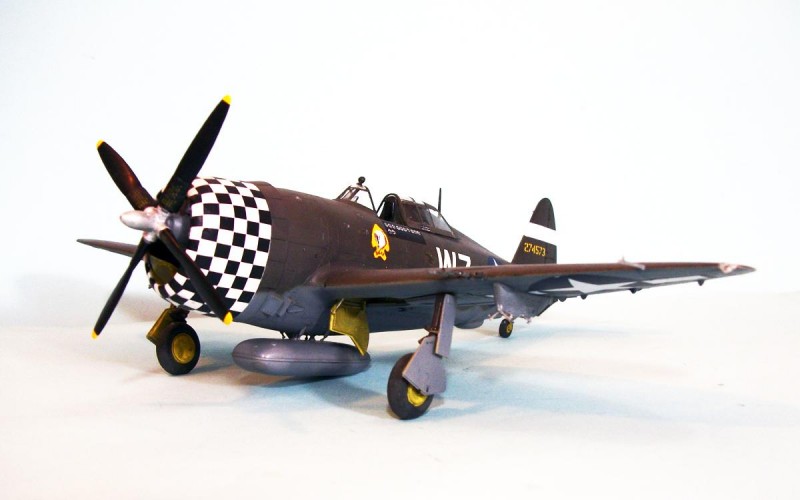
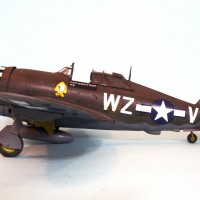
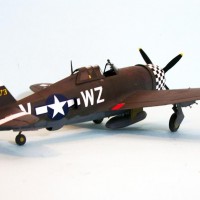
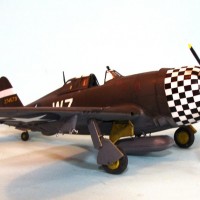
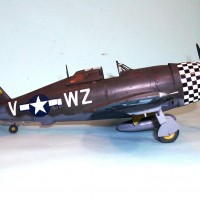
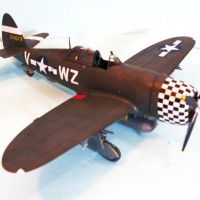
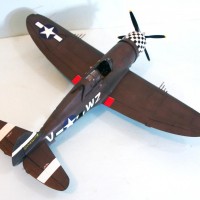
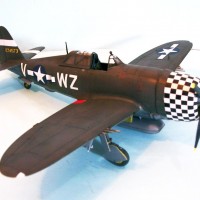
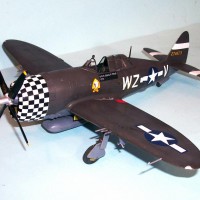

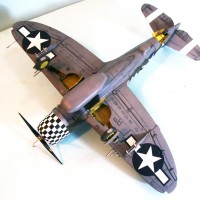
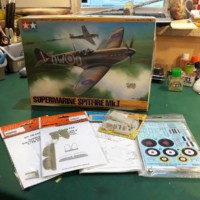
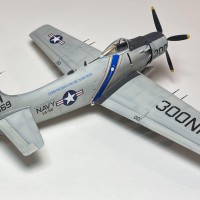
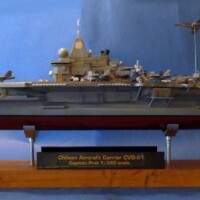
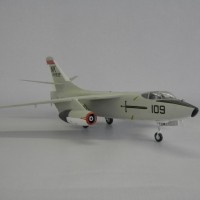
"pre-order at Amazon (pay no attention to the “place holder” artwork shown, Mark Postlethwait’s painting of Gene Roberts scoring his 2nd of 3 victories on 30 July 1943 is vastly superior"
Good news,Amazon has up dated their site to show Mark Postlethwait's art work of a P-47C rolling onto the tail of a Fw-190. This is one of the better book covers showing a A/C in battle. Many of the Osprey book covers show some good generic 3/4 profiles but, this cover does a good job of re-enacting a little history. While showing the proper control inputs and the unique bellie tank of the C model Jug.
You're right, it does show the right cover. I consider myself really lucky they assigned Mark to the project. He's also going to do "Aces of Fighting 2," and I think we will do Spider Webb's low level fight over Guam where he got 7 (would have been credited with 9 if his camera hadn't jammed).
beautiful...i'm a s****r for the 78th...love those checks...your getting a little long winded on these history lessons
You're right, this one is a bit long - it's excerpted from the book.
exciting stuff though...i'm addicted to dogfights
Then you'll like the book.
I realize I am really late on this one but I hope I can still ask you a question. I am building this very airplane as we speak. I am a born and raised Okie. living in Oklahoma City my entire life. I bought and have read your book on the 78th and loved it. I was wondering if you have or have seen a photo of this very airplane? As much as I have researched I have not located a photo of this very aircraft. If you could point me in the right direction for a photo it would be appreciated.
I hope mine model comes out as nice as yours.
Jim Root
I did this from a photo in Curt Shepard's book on the 78th. If you do what I did you will be accurate.
This is the original "Okie" that had its markings changed after he took delivery of Okie II, the silver P-47D-23RE that he used in May-June 1944.
I am using your build as a guide for mine. I really liked this one because of the checkerboard cowling.
Thank you for the heads up on the book. I never thought about looking there. I just found the picture. Thanks again.